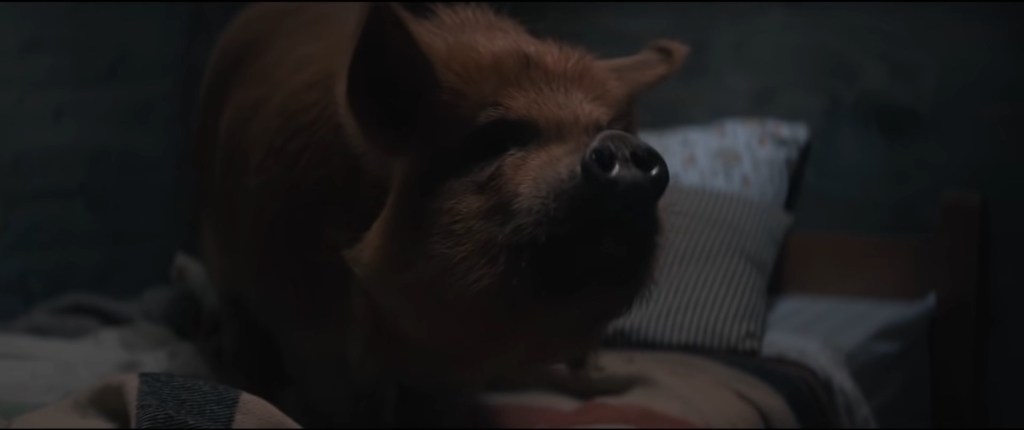Even more so than many Cage vehicles of the past decade, Michael Sarnoski’s debut feature Pig is a gem, like a truffle hidden deep in the forest, that is fated to attain a cult status. This gritty neo-noir thriller follows Nicolas Cage as the hermit woodsman “Robin” as he teams up with young hustler Amir (Alex Wolff) to search for his prized truffle pig, stolen from him by greedy city-dwellers in Portland. As ridiculous as it sounds, the film is not a comedy in the least, but one of the best dramas of the year so far. If this description confuses you, you’re likely not alone; at the main showing on the film’s opening night, I was one in a total audience of three. However, viewers bold enough to venture out to see Pig will be rewarded as Sarnoski’s film continuously subverts typical revenge-thriller story beats. With intimate and restrained cinematography and acting (yes, even from Cage) the story builds to a gut-wrenching climax that is not easily forgotten. This is the sort of film where viewers might be inclined to remain in their seats through the end credits to process its emotional weight.
The key consideration separating Pig from its genre peers like Blue Ruin is simple: love. This is not the brutal Nic Cage revenge film that fans of his might expect and yearn for after the stylish sucker punch of Mandy. And honestly, it’s better for it. Like Mandy, the film is divided into several acts with colorfully descriptive names like “Mom’s French Toast and Deconstructed Scallops,” which embody the rich aesthetic texture that runs throughout the film. Set in the Oregon woods and Portland, the rustic shots of the outdoors establish a visual warmth, only to be sliced apart by the darkness and intensity of the city’s back alleys and crowded storerooms. Delectable shots of food are presented in many scenes, as the characters maneuver between the underworld market of ingredient suppliers and the fancy dining rooms of high-brow Portland restaurants. It is deeply ironic that a movie called “Pig” should conjure ideas of such pleasant aromas. Also worth noting is the titular pig, who is one of the cutest animals I’ve ever seen in a film, with its bright orange fur and whiskers like a red fox that help to form an instant emotional bond with viewers.
With a reserved strength and rapt dedication, Cage dominates the screen, beyond his burly stature. Though Cage stands at a height of 6’, same as co-star Wolff, he is shot in such a way that he physically imposes over all other characters, giving his performance greater strength and conviction. Initially an irritable loner, Cage’s Robin rejects the materialist lifestyles of those around him to pursue his own passions while isolated in the woods. After he is roped back to the city, he takes the opportunity to re-educate others about the value of life and the consequences of pursuing soulless work on the culture at large. Aside from the occasional scene of “Cage rage,” the nouveau shamanic acting practitioner performs with uncharacteristic subtlety. As a protagonist, Robin receives a more holistic characterization than either of Cage’s similar woodsman roles in Joe and Mandy, allowing him to express great emotional range and seamlessly fit within the film, rather than be an outlier for his unique acting tendencies. In a powerful monologue halfway into the film, Cage cuts straight to the viewer through an intimate long take where he urges people to ignore critics and live each day like it’s their last. These moments add up to a movie that is legitimately life-affirming, and shows how we can find comfort, instead of fear, in death.
Many juxtapositions are posed as the film explores cultural divisions between Portland and its surrounding rural environments. Though appearing like a typical fish out of water narrative, the film deconstructs these conventions with frequent, innovative plot twists. Each pivot deepens the development of the characters and viewers’ understanding of their fears, regrets, and how past traumas continue to shape their present. With this rich layering, a leisurely story pace, and quaint 90-minute runtime, the film makes a staggering impact without overstaying its welcome.
The soundtrack, which consciously foregrounds certain uninspired classical music selections, appropriately characterizes wealthy characters’ superficial performances of perceived status for the public. Such passive and meaningless engagements with culture and art are Pig’s target of critique. The film carries a relatable message in its calls for viewers to live purposefully and prioritize their passions in spite of any anxieties about breaking societal conformance.
Sarnoski’s directorial debut immediately establishes him as a new voice to watch. The screenplay, written with Vanessa Block as her first writing credit, expertly balances and explores conflicting tones of taut drama and pensive openness, intensity and quietness, tenderness and revenge. Though a difficult film to recommend to all viewers, and a hard piece to market on account of its story being best experienced first-hand, Pig delivers miles beyond what its nondescript title and simple premise might suggest and gives a strong indication that the Nicolas Cage renaissance of the 2010s will continue strongly into the 2020s.



0 comments on “Pig ★★★½”